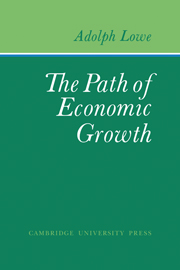Book contents
- Frontmatter
- Contents
- Preface
- Acknowledgments
- PART I The Basic Model
- PART II Changes in the Rate of Change
- 11 The Setting of the Problem
- 12 A Bird's-Eye View of an Expanding Traverse
- 13 On the Short-Period Variability of the Capital–Labor Ratio
- 14 Adjustment to a Higher Rate of Growth of Labor Supply in a Free Market. I. Structure Analysis
- 15 Adjustment to a Higher Rate of Growth of Labor Supply in a Free Market. II. Force Analysis
- 16 Adjustment to a Higher Rate of Growth of Labor Supply in a Collectivist System
- 17 Some Comments on the Role of Working Capital in the Traverse
- 18 Instrumental Analysis of Decline in the Rate of Growth of Labor Supply
- PART III Changes in the Rate of Change
- PART IV Changes in the Rate of Change
- Appendix: An Alternative Presentation of Lowe's Basic Model
- Glossary of Recurring Symbols
- Name Index
- Subject Index
14 - Adjustment to a Higher Rate of Growth of Labor Supply in a Free Market. I. Structure Analysis
Published online by Cambridge University Press: 07 October 2011
- Frontmatter
- Contents
- Preface
- Acknowledgments
- PART I The Basic Model
- PART II Changes in the Rate of Change
- 11 The Setting of the Problem
- 12 A Bird's-Eye View of an Expanding Traverse
- 13 On the Short-Period Variability of the Capital–Labor Ratio
- 14 Adjustment to a Higher Rate of Growth of Labor Supply in a Free Market. I. Structure Analysis
- 15 Adjustment to a Higher Rate of Growth of Labor Supply in a Free Market. II. Force Analysis
- 16 Adjustment to a Higher Rate of Growth of Labor Supply in a Collectivist System
- 17 Some Comments on the Role of Working Capital in the Traverse
- 18 Instrumental Analysis of Decline in the Rate of Growth of Labor Supply
- PART III Changes in the Rate of Change
- PART IV Changes in the Rate of Change
- Appendix: An Alternative Presentation of Lowe's Basic Model
- Glossary of Recurring Symbols
- Name Index
- Subject Index
Summary
The present chapter, which is supplemented in Chapter 18 by the study of a decline in the rate of growth of labor supply, contains the core of our investigations. Although it concentrates on a change in the rate of labor supply but disregards changes in the rate of return and in technology, it will set the pattern for describing, in slow motion and in quantitative precision, the sectoral contortions of the traverse that lead from an initial level of dynamic equilibrium to a higher level. Because in this chapter we try to reproduce the complexity of the actual phenomena, analysis of these contortions will prove a very intricate undertaking. To facilitate understanding, we shall carry it out in several stages of decreasing abstraction.
Following the procedure outlined in our literary presentation of the traverse, we shall build up in Sections II–IV a Primary Model that insulates the strategic sectoral shifts, as an initial growth stimulus sets them in motion, from other events occurring at the same time. The subsequent sections will integrate these events into a more complex Secondary Model. In Chapter 15, we shall-underpin our structure analysis by a complementary force analysis and also illustrate the findings symbolically expressed in the present chapter with a numerical example.
Assume a market system reduced to the two-strata organization defined earlier, moving in dynamic equilibrium with a growth rate a of labor supply. Assume further that the dynamic process of growth can be subdivided into finite periods.
- Type
- Chapter
- Information
- The Path of Economic Growth , pp. 123 - 145Publisher: Cambridge University PressPrint publication year: 1976



